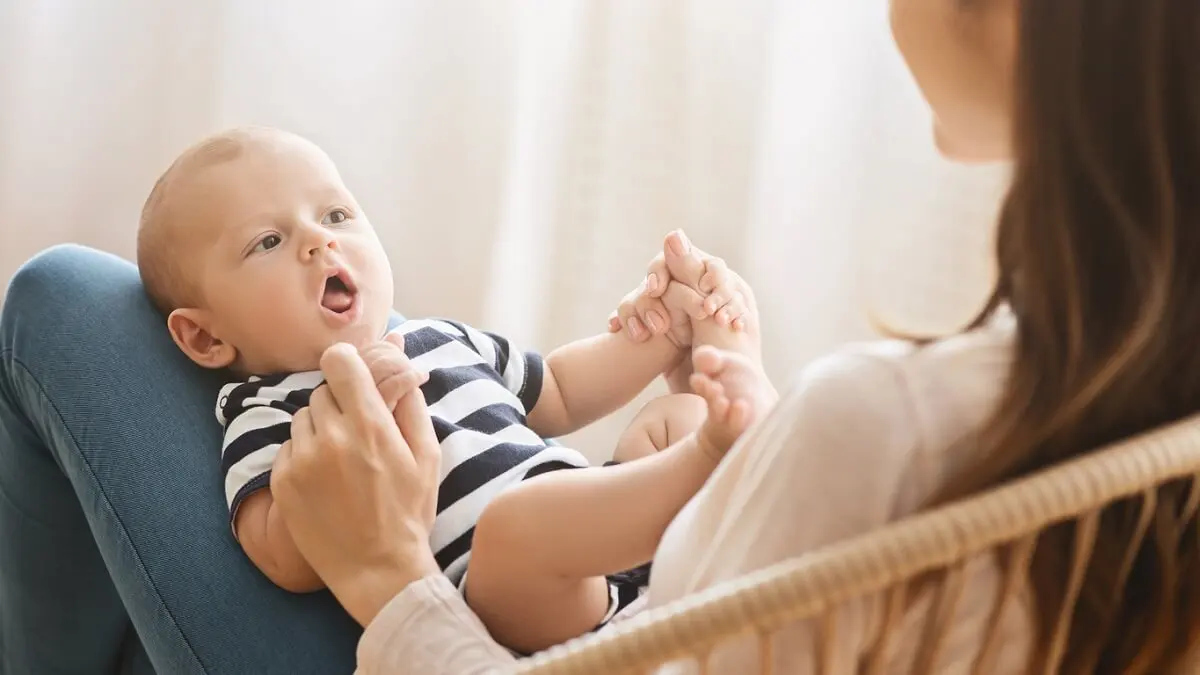What's "Baby Talk" and How Does it Benefit Babies?

“Baby talk” is that special way that almost everyone has of speaking to babies. It appears spontaneously in many cultures and is characterized by the use of an exaggerated and musical tone, with repetitive and simple words.
The baby usually responds by paying more attention when spoken to in this way. It’s now commonly known that baby talk is not only a loving way of communicating with the baby, but also helps to improve the baby’s language skills.
In fact, there have even been different forms of baby talk that have been identified: mother baby talk and father baby talk. When both are included, it’s called “parent baby talk.”
What is baby talk?
Baby talk is usually defined as the language used by adults to communicate with babies. The essential characteristic of this is that, although the adult speaks in the correct way, when speaking with a baby, their tone and pronunciation are modified.
Although babies don’t understand what adults say to them, they usually respond with pleasure. This type of communication is beneficial for little ones.
Baby talk also includes onomatopoeia or simplification of words. It also includes gestures, expressions and physical contact. The baby is not indifferent to this, but responds to the interlocutor with smiles, an attentive gaze, or hand movements.
The benefits of baby talk
Most experts agree that baby talk favors the development of language in the child. Some define it as a “social hook” for the baby’s brain. This is a stimulus that fosters communication skills.
In fact, a study conducted in 2018 found that babies who spoken to in “baby talk” produced more words at 14 months than those who did not receive this stimulus.
Another study published in 2020 examined the linguistic evolution of infants up to 18 months. To do so, it divided their families into two groups. The first received training, and the second did not.
At the end of the study, it was found that children from families that had used baby talk managed 100 words on average. In the children of the other families, their vocabulary reached only 60 words.
On the other hand, it has been found that the use of this type of speech reflects positive emotions and feelings towards the child. This promotes constructive and affectionate communication between the baby and the speaker. All studies indicate that baby talk is not a method of teaching language, but a factor that facilitates its learning.

The characteristics of baby talk
The most characteristic element of baby is slow speech, with a detailed pronunciation and a higher-pitched tone of voice. Articulation is more emphatic, and there’s usually more use of facial expression. On the other hand, utterances are short and simple.
We think you may also enjoy reading this article: Weight, Sleep, and Development in 4-month-old Babies
Word repetition
When baby talk is used, words are repeated with the more or less explicit intention that the baby learns them. Things are said with a lot of emphasis. Then they’re repeated. If the baby tries to imitate those sounds to some extent, the adults make them again.
Verb tense and diminutives
Another distinctive feature is the use of verb tense: baby talk is always spoken in the present tense. It’s as if it is understood that it’s impossible for the baby to assimilate the concepts of the past and future.
Likewise, diminutives and onomatopoeias are often used as substitutes for normal words. For example, doggy or woof woof.
Third-person and grammatical expansion
With baby talk, one speaks in the third person about oneself or others. For example, the mother doesn’t say “I’m tired,” but “mommy is tired.”
Likewise, when the baby says his or her first words, the caregiver completes hir or her grammatical meaning. For example, if the child says bibi to ask for a bottle, the caregiver answers: “Does the baby want a bottle? I’ll get it for you.”
Other interesting facts about baby talk
It’s interesting to note that baby is not only used with babies. Many couples use this language to talk to their loved ones. Apparently, this type of communication increases oxytocin and dopamine levels.
In this case, it no longer serves the function of facilitating communication, as it does between an adult and a baby. The role is to interact in an affectionate and sweet way.
It is also common for this type of communication to be used with pets, particularly when affection is being offered. Although animals aren’t able to understand the meaning of words, they do pick up on the emotion that accompanies them.

Like this article? You may also like to read: Tips on How to Relieve an Ear Infection in Babies and Children
Communication is part of the relationship
Human communication is a complex dimension that encompasses meaning, context, and emotions. Everything indicates that the use of baby is positive, not only because it favors the child’s linguistic development, but also because it provokes an emotional bond.
Babies also need to be educated in the art of human communication. They’re very sensitive and attentive to what they receive from their caregivers. Baby talk establishes social complicity which your little one will respond to with joy.
All cited sources were thoroughly reviewed by our team to ensure their quality, reliability, currency, and validity. The bibliography of this article was considered reliable and of academic or scientific accuracy.
- Eckart, K. (2018, 26 noviembre). Parents learn, babies talk: How coaching moms and dads leads to better language skills among infants. UW News. https://www.washington.edu/news/2018/11/26/parents-learn-babies-talk-how-coaching-moms-and-dads-leads-to-better-language-skills-among-infants/.
- Eckart, K. (2020, 3 febrero). Not just âbaby talkâ: Parentese helps parents, babies make âconversationâ and boosts language development. UW News. https://www.washington.edu/news/2020/02/03/not-just-baby-talk-parentese-helps-parents-babies-make-conversation-and-boosts-language-development/.
- Taverna, A. S. (2021). Motherese in the Wichi Language (El maternés en la lengua wichí). Journal for the Study of Education and Development, 44(2), 303-335.
This text is provided for informational purposes only and does not replace consultation with a professional. If in doubt, consult your specialist.








